Rebranding Impact on House of Fraser Brand Image
VerifiedAdded on 2019/12/03
|34
|13098
|187
Thesis and Dissertation
AI Summary
This document presents a comprehensive thesis exploring the impact of rebranding strategies on the brand image of House of Fraser's Oxford Street flagship store. It includes a literature review covering branding, rebranding, and associated risks, followed by a detailed research methodology outlining the data collection and analysis process. The study aims to assess the effectiveness of the rebranding efforts and provide recommendations for future brand management strategies. The research uses a questionnaire survey to gather data from female shoppers, focusing on their perceptions of the brand before and after the rebranding. The thesis also addresses ethical considerations and the limitations of the research.
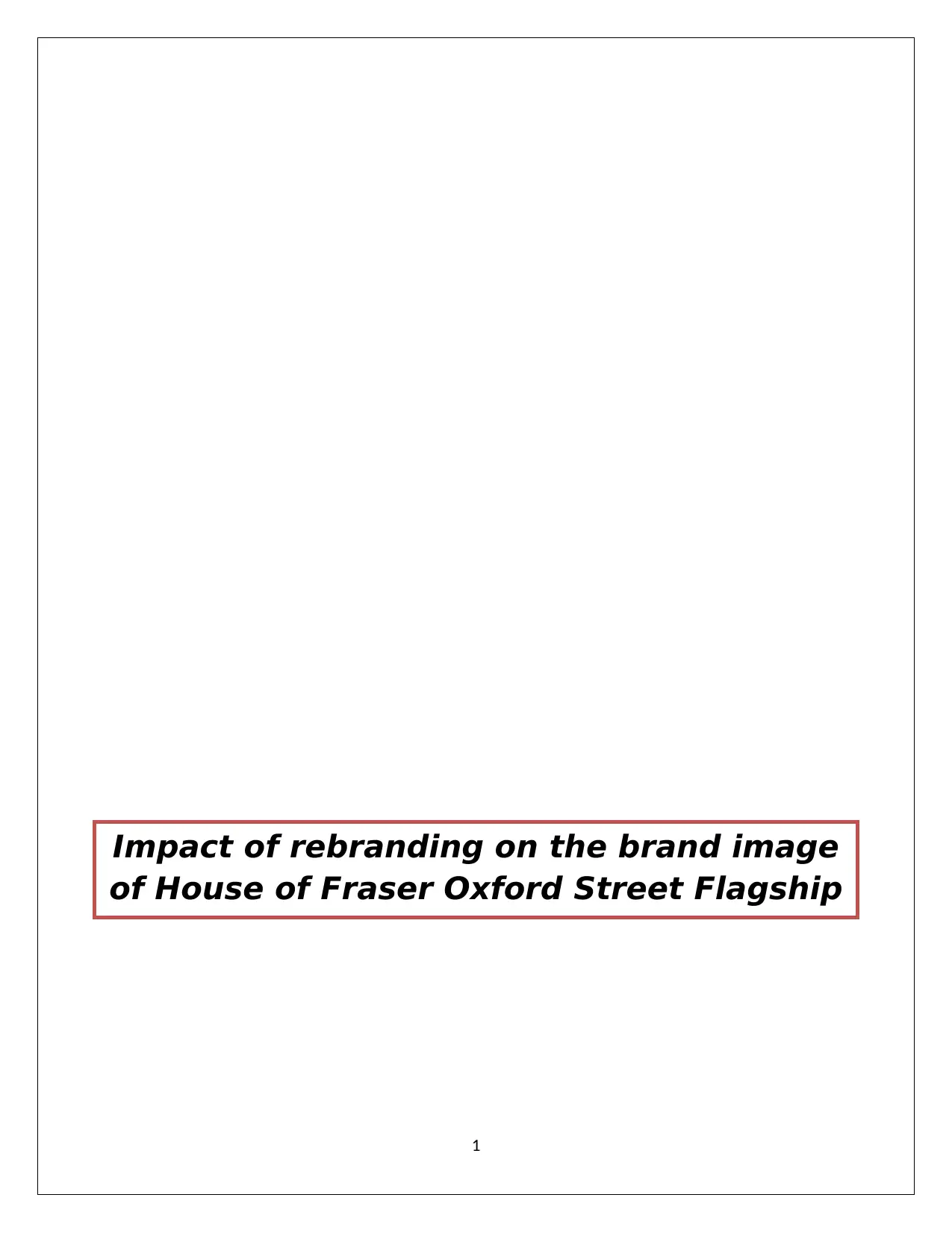
1
Impact of rebranding on the brand image
of House of Fraser Oxford Street Flagship
Store
Impact of rebranding on the brand image
of House of Fraser Oxford Street Flagship
Store
Paraphrase This Document
Need a fresh take? Get an instant paraphrase of this document with our AI Paraphraser
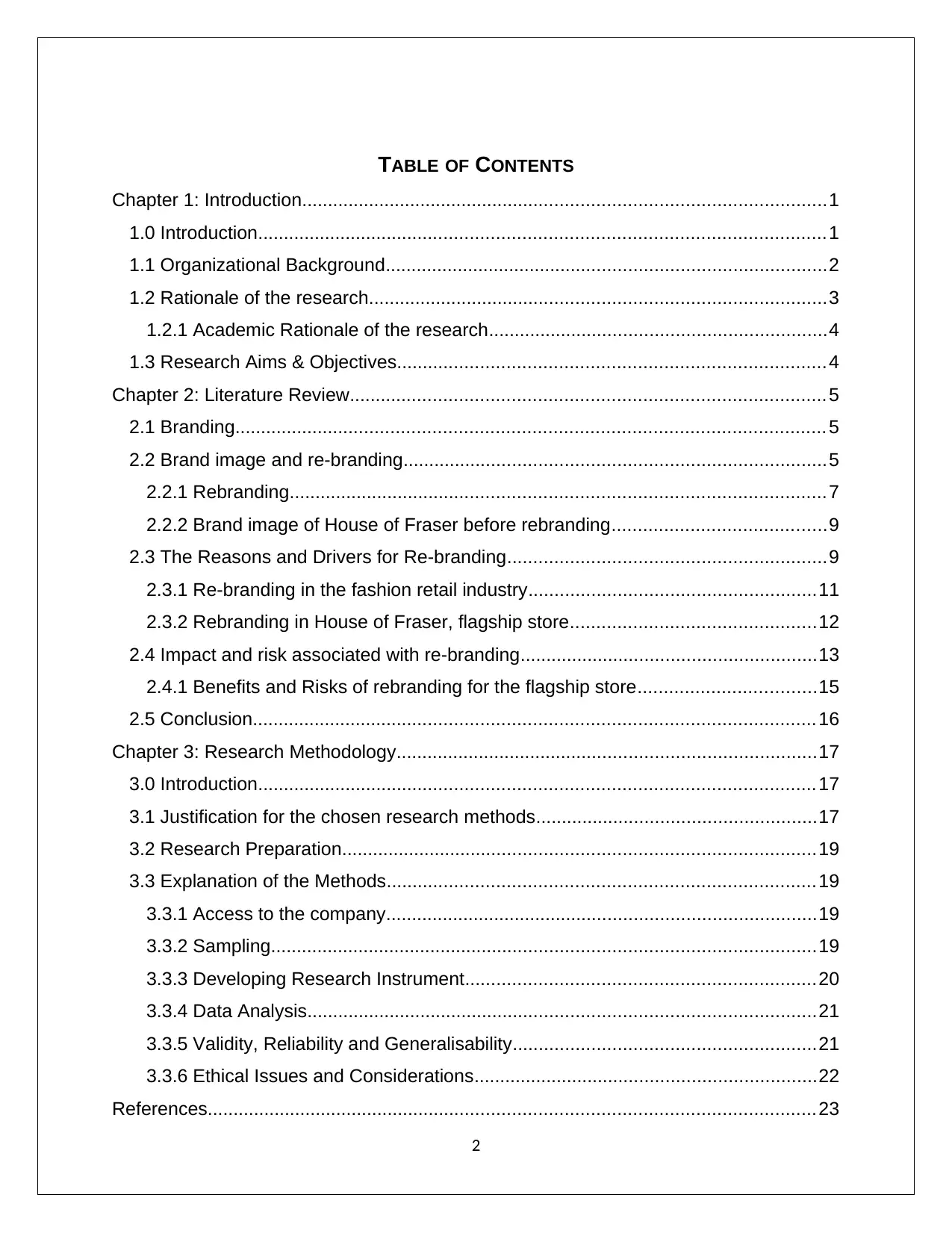
TABLE OF CONTENTS
Chapter 1: Introduction.....................................................................................................1
1.0 Introduction.............................................................................................................1
1.1 Organizational Background.....................................................................................2
1.2 Rationale of the research........................................................................................3
1.2.1 Academic Rationale of the research.................................................................4
1.3 Research Aims & Objectives..................................................................................4
Chapter 2: Literature Review...........................................................................................5
2.1 Branding................................................................................................................. 5
2.2 Brand image and re-branding.................................................................................5
2.2.1 Rebranding.......................................................................................................7
2.2.2 Brand image of House of Fraser before rebranding.........................................9
2.3 The Reasons and Drivers for Re-branding.............................................................9
2.3.1 Re-branding in the fashion retail industry.......................................................11
2.3.2 Rebranding in House of Fraser, flagship store...............................................12
2.4 Impact and risk associated with re-branding.........................................................13
2.4.1 Benefits and Risks of rebranding for the flagship store..................................15
2.5 Conclusion............................................................................................................ 16
Chapter 3: Research Methodology.................................................................................17
3.0 Introduction........................................................................................................... 17
3.1 Justification for the chosen research methods......................................................17
3.2 Research Preparation...........................................................................................19
3.3 Explanation of the Methods..................................................................................19
3.3.1 Access to the company...................................................................................19
3.3.2 Sampling.........................................................................................................19
3.3.3 Developing Research Instrument...................................................................20
3.3.4 Data Analysis..................................................................................................21
3.3.5 Validity, Reliability and Generalisability..........................................................21
3.3.6 Ethical Issues and Considerations..................................................................22
References.....................................................................................................................23
2
Chapter 1: Introduction.....................................................................................................1
1.0 Introduction.............................................................................................................1
1.1 Organizational Background.....................................................................................2
1.2 Rationale of the research........................................................................................3
1.2.1 Academic Rationale of the research.................................................................4
1.3 Research Aims & Objectives..................................................................................4
Chapter 2: Literature Review...........................................................................................5
2.1 Branding................................................................................................................. 5
2.2 Brand image and re-branding.................................................................................5
2.2.1 Rebranding.......................................................................................................7
2.2.2 Brand image of House of Fraser before rebranding.........................................9
2.3 The Reasons and Drivers for Re-branding.............................................................9
2.3.1 Re-branding in the fashion retail industry.......................................................11
2.3.2 Rebranding in House of Fraser, flagship store...............................................12
2.4 Impact and risk associated with re-branding.........................................................13
2.4.1 Benefits and Risks of rebranding for the flagship store..................................15
2.5 Conclusion............................................................................................................ 16
Chapter 3: Research Methodology.................................................................................17
3.0 Introduction........................................................................................................... 17
3.1 Justification for the chosen research methods......................................................17
3.2 Research Preparation...........................................................................................19
3.3 Explanation of the Methods..................................................................................19
3.3.1 Access to the company...................................................................................19
3.3.2 Sampling.........................................................................................................19
3.3.3 Developing Research Instrument...................................................................20
3.3.4 Data Analysis..................................................................................................21
3.3.5 Validity, Reliability and Generalisability..........................................................21
3.3.6 Ethical Issues and Considerations..................................................................22
References.....................................................................................................................23
2
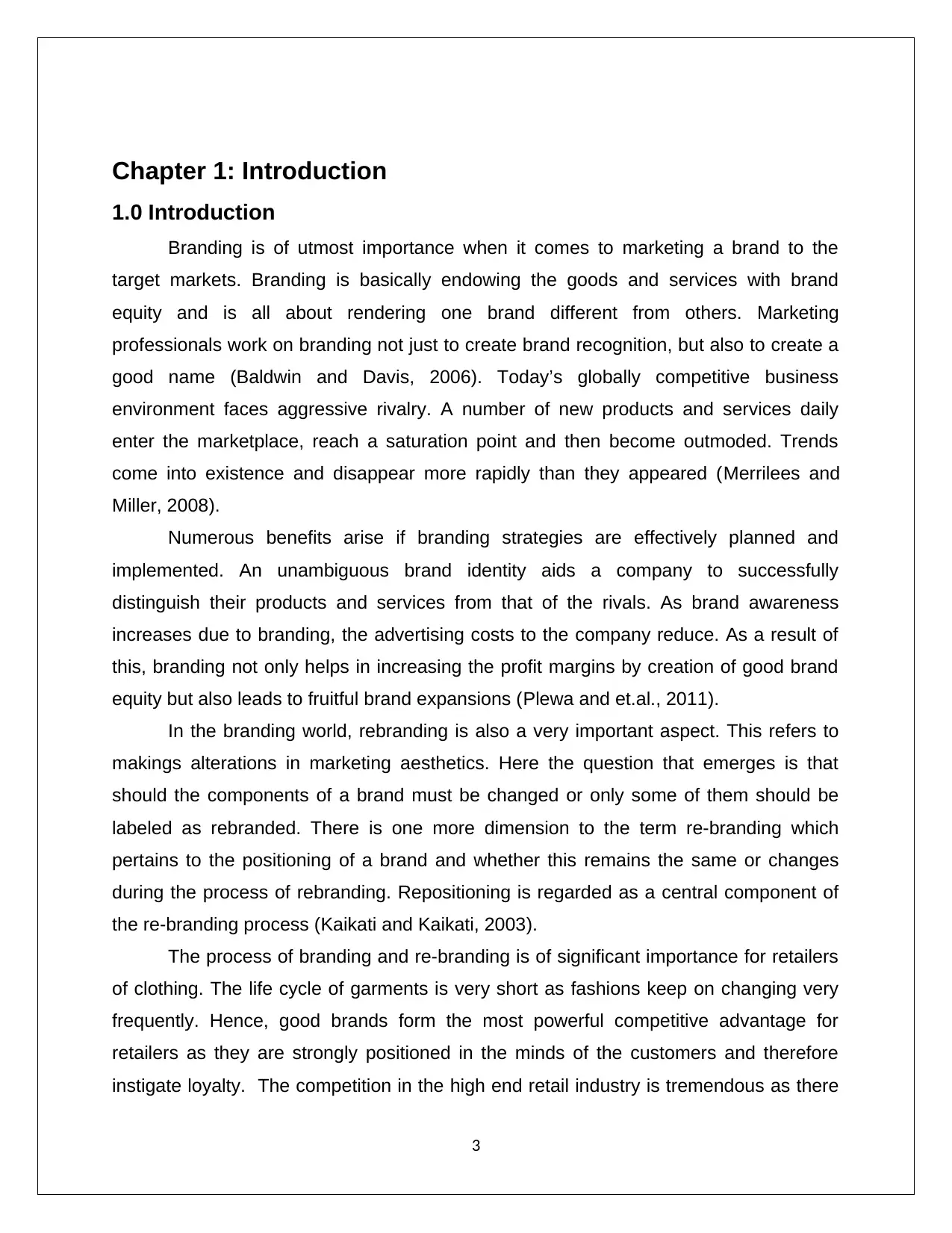
Chapter 1: Introduction
1.0 Introduction
Branding is of utmost importance when it comes to marketing a brand to the
target markets. Branding is basically endowing the goods and services with brand
equity and is all about rendering one brand different from others. Marketing
professionals work on branding not just to create brand recognition, but also to create a
good name (Baldwin and Davis, 2006). Today’s globally competitive business
environment faces aggressive rivalry. A number of new products and services daily
enter the marketplace, reach a saturation point and then become outmoded. Trends
come into existence and disappear more rapidly than they appeared (Merrilees and
Miller, 2008).
Numerous benefits arise if branding strategies are effectively planned and
implemented. An unambiguous brand identity aids a company to successfully
distinguish their products and services from that of the rivals. As brand awareness
increases due to branding, the advertising costs to the company reduce. As a result of
this, branding not only helps in increasing the profit margins by creation of good brand
equity but also leads to fruitful brand expansions (Plewa and et.al., 2011).
In the branding world, rebranding is also a very important aspect. This refers to
makings alterations in marketing aesthetics. Here the question that emerges is that
should the components of a brand must be changed or only some of them should be
labeled as rebranded. There is one more dimension to the term re-branding which
pertains to the positioning of a brand and whether this remains the same or changes
during the process of rebranding. Repositioning is regarded as a central component of
the re-branding process (Kaikati and Kaikati, 2003).
The process of branding and re-branding is of significant importance for retailers
of clothing. The life cycle of garments is very short as fashions keep on changing very
frequently. Hence, good brands form the most powerful competitive advantage for
retailers as they are strongly positioned in the minds of the customers and therefore
instigate loyalty. The competition in the high end retail industry is tremendous as there
3
1.0 Introduction
Branding is of utmost importance when it comes to marketing a brand to the
target markets. Branding is basically endowing the goods and services with brand
equity and is all about rendering one brand different from others. Marketing
professionals work on branding not just to create brand recognition, but also to create a
good name (Baldwin and Davis, 2006). Today’s globally competitive business
environment faces aggressive rivalry. A number of new products and services daily
enter the marketplace, reach a saturation point and then become outmoded. Trends
come into existence and disappear more rapidly than they appeared (Merrilees and
Miller, 2008).
Numerous benefits arise if branding strategies are effectively planned and
implemented. An unambiguous brand identity aids a company to successfully
distinguish their products and services from that of the rivals. As brand awareness
increases due to branding, the advertising costs to the company reduce. As a result of
this, branding not only helps in increasing the profit margins by creation of good brand
equity but also leads to fruitful brand expansions (Plewa and et.al., 2011).
In the branding world, rebranding is also a very important aspect. This refers to
makings alterations in marketing aesthetics. Here the question that emerges is that
should the components of a brand must be changed or only some of them should be
labeled as rebranded. There is one more dimension to the term re-branding which
pertains to the positioning of a brand and whether this remains the same or changes
during the process of rebranding. Repositioning is regarded as a central component of
the re-branding process (Kaikati and Kaikati, 2003).
The process of branding and re-branding is of significant importance for retailers
of clothing. The life cycle of garments is very short as fashions keep on changing very
frequently. Hence, good brands form the most powerful competitive advantage for
retailers as they are strongly positioned in the minds of the customers and therefore
instigate loyalty. The competition in the high end retail industry is tremendous as there
3
⊘ This is a preview!⊘
Do you want full access?
Subscribe today to unlock all pages.

Trusted by 1+ million students worldwide
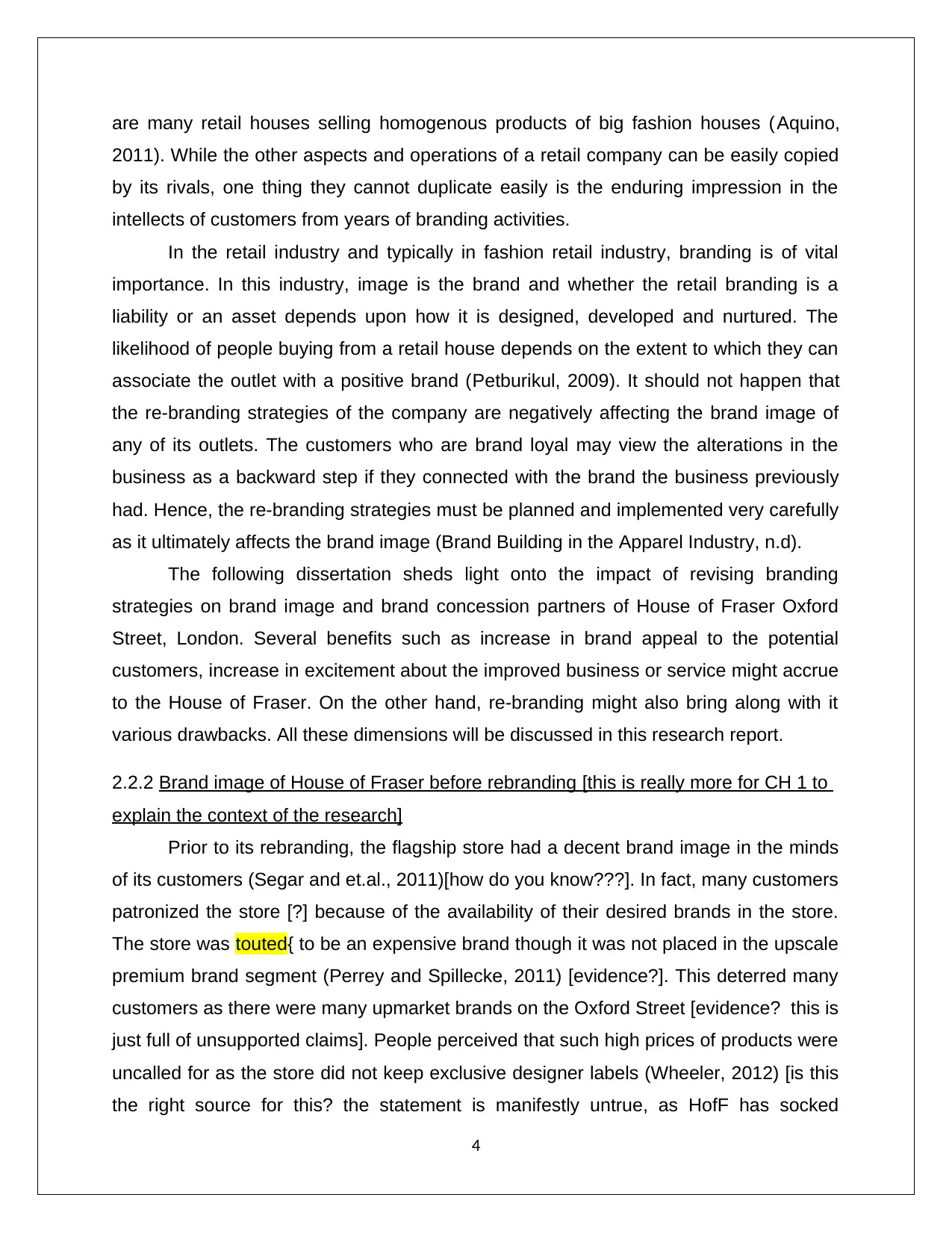
are many retail houses selling homogenous products of big fashion houses (Aquino,
2011). While the other aspects and operations of a retail company can be easily copied
by its rivals, one thing they cannot duplicate easily is the enduring impression in the
intellects of customers from years of branding activities.
In the retail industry and typically in fashion retail industry, branding is of vital
importance. In this industry, image is the brand and whether the retail branding is a
liability or an asset depends upon how it is designed, developed and nurtured. The
likelihood of people buying from a retail house depends on the extent to which they can
associate the outlet with a positive brand (Petburikul, 2009). It should not happen that
the re-branding strategies of the company are negatively affecting the brand image of
any of its outlets. The customers who are brand loyal may view the alterations in the
business as a backward step if they connected with the brand the business previously
had. Hence, the re-branding strategies must be planned and implemented very carefully
as it ultimately affects the brand image (Brand Building in the Apparel Industry, n.d).
The following dissertation sheds light onto the impact of revising branding
strategies on brand image and brand concession partners of House of Fraser Oxford
Street, London. Several benefits such as increase in brand appeal to the potential
customers, increase in excitement about the improved business or service might accrue
to the House of Fraser. On the other hand, re-branding might also bring along with it
various drawbacks. All these dimensions will be discussed in this research report.
2.2.2 Brand image of House of Fraser before rebranding [this is really more for CH 1 to
explain the context of the research]
Prior to its rebranding, the flagship store had a decent brand image in the minds
of its customers (Segar and et.al., 2011)[how do you know???]. In fact, many customers
patronized the store [?] because of the availability of their desired brands in the store.
The store was touted{ to be an expensive brand though it was not placed in the upscale
premium brand segment (Perrey and Spillecke, 2011) [evidence?]. This deterred many
customers as there were many upmarket brands on the Oxford Street [evidence? this is
just full of unsupported claims]. People perceived that such high prices of products were
uncalled for as the store did not keep exclusive designer labels (Wheeler, 2012) [is this
the right source for this? the statement is manifestly untrue, as HofF has socked
4
2011). While the other aspects and operations of a retail company can be easily copied
by its rivals, one thing they cannot duplicate easily is the enduring impression in the
intellects of customers from years of branding activities.
In the retail industry and typically in fashion retail industry, branding is of vital
importance. In this industry, image is the brand and whether the retail branding is a
liability or an asset depends upon how it is designed, developed and nurtured. The
likelihood of people buying from a retail house depends on the extent to which they can
associate the outlet with a positive brand (Petburikul, 2009). It should not happen that
the re-branding strategies of the company are negatively affecting the brand image of
any of its outlets. The customers who are brand loyal may view the alterations in the
business as a backward step if they connected with the brand the business previously
had. Hence, the re-branding strategies must be planned and implemented very carefully
as it ultimately affects the brand image (Brand Building in the Apparel Industry, n.d).
The following dissertation sheds light onto the impact of revising branding
strategies on brand image and brand concession partners of House of Fraser Oxford
Street, London. Several benefits such as increase in brand appeal to the potential
customers, increase in excitement about the improved business or service might accrue
to the House of Fraser. On the other hand, re-branding might also bring along with it
various drawbacks. All these dimensions will be discussed in this research report.
2.2.2 Brand image of House of Fraser before rebranding [this is really more for CH 1 to
explain the context of the research]
Prior to its rebranding, the flagship store had a decent brand image in the minds
of its customers (Segar and et.al., 2011)[how do you know???]. In fact, many customers
patronized the store [?] because of the availability of their desired brands in the store.
The store was touted{ to be an expensive brand though it was not placed in the upscale
premium brand segment (Perrey and Spillecke, 2011) [evidence?]. This deterred many
customers as there were many upmarket brands on the Oxford Street [evidence? this is
just full of unsupported claims]. People perceived that such high prices of products were
uncalled for as the store did not keep exclusive designer labels (Wheeler, 2012) [is this
the right source for this? the statement is manifestly untrue, as HofF has socked
4
Paraphrase This Document
Need a fresh take? Get an instant paraphrase of this document with our AI Paraphraser
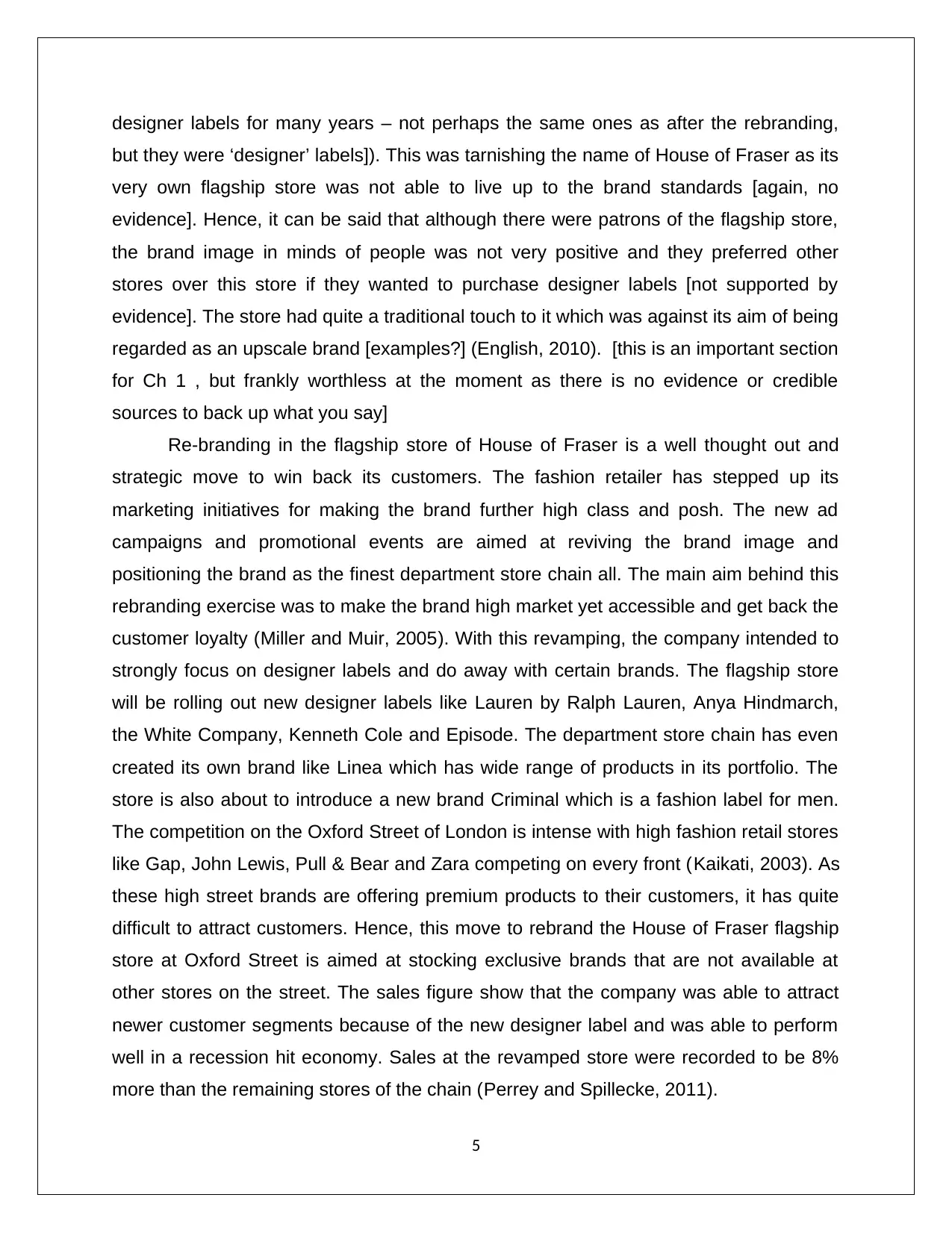
designer labels for many years – not perhaps the same ones as after the rebranding,
but they were ‘designer’ labels]). This was tarnishing the name of House of Fraser as its
very own flagship store was not able to live up to the brand standards [again, no
evidence]. Hence, it can be said that although there were patrons of the flagship store,
the brand image in minds of people was not very positive and they preferred other
stores over this store if they wanted to purchase designer labels [not supported by
evidence]. The store had quite a traditional touch to it which was against its aim of being
regarded as an upscale brand [examples?] (English, 2010). [this is an important section
for Ch 1 , but frankly worthless at the moment as there is no evidence or credible
sources to back up what you say]
Re-branding in the flagship store of House of Fraser is a well thought out and
strategic move to win back its customers. The fashion retailer has stepped up its
marketing initiatives for making the brand further high class and posh. The new ad
campaigns and promotional events are aimed at reviving the brand image and
positioning the brand as the finest department store chain all. The main aim behind this
rebranding exercise was to make the brand high market yet accessible and get back the
customer loyalty (Miller and Muir, 2005). With this revamping, the company intended to
strongly focus on designer labels and do away with certain brands. The flagship store
will be rolling out new designer labels like Lauren by Ralph Lauren, Anya Hindmarch,
the White Company, Kenneth Cole and Episode. The department store chain has even
created its own brand like Linea which has wide range of products in its portfolio. The
store is also about to introduce a new brand Criminal which is a fashion label for men.
The competition on the Oxford Street of London is intense with high fashion retail stores
like Gap, John Lewis, Pull & Bear and Zara competing on every front (Kaikati, 2003). As
these high street brands are offering premium products to their customers, it has quite
difficult to attract customers. Hence, this move to rebrand the House of Fraser flagship
store at Oxford Street is aimed at stocking exclusive brands that are not available at
other stores on the street. The sales figure show that the company was able to attract
newer customer segments because of the new designer label and was able to perform
well in a recession hit economy. Sales at the revamped store were recorded to be 8%
more than the remaining stores of the chain (Perrey and Spillecke, 2011).
5
but they were ‘designer’ labels]). This was tarnishing the name of House of Fraser as its
very own flagship store was not able to live up to the brand standards [again, no
evidence]. Hence, it can be said that although there were patrons of the flagship store,
the brand image in minds of people was not very positive and they preferred other
stores over this store if they wanted to purchase designer labels [not supported by
evidence]. The store had quite a traditional touch to it which was against its aim of being
regarded as an upscale brand [examples?] (English, 2010). [this is an important section
for Ch 1 , but frankly worthless at the moment as there is no evidence or credible
sources to back up what you say]
Re-branding in the flagship store of House of Fraser is a well thought out and
strategic move to win back its customers. The fashion retailer has stepped up its
marketing initiatives for making the brand further high class and posh. The new ad
campaigns and promotional events are aimed at reviving the brand image and
positioning the brand as the finest department store chain all. The main aim behind this
rebranding exercise was to make the brand high market yet accessible and get back the
customer loyalty (Miller and Muir, 2005). With this revamping, the company intended to
strongly focus on designer labels and do away with certain brands. The flagship store
will be rolling out new designer labels like Lauren by Ralph Lauren, Anya Hindmarch,
the White Company, Kenneth Cole and Episode. The department store chain has even
created its own brand like Linea which has wide range of products in its portfolio. The
store is also about to introduce a new brand Criminal which is a fashion label for men.
The competition on the Oxford Street of London is intense with high fashion retail stores
like Gap, John Lewis, Pull & Bear and Zara competing on every front (Kaikati, 2003). As
these high street brands are offering premium products to their customers, it has quite
difficult to attract customers. Hence, this move to rebrand the House of Fraser flagship
store at Oxford Street is aimed at stocking exclusive brands that are not available at
other stores on the street. The sales figure show that the company was able to attract
newer customer segments because of the new designer label and was able to perform
well in a recession hit economy. Sales at the revamped store were recorded to be 8%
more than the remaining stores of the chain (Perrey and Spillecke, 2011).
5
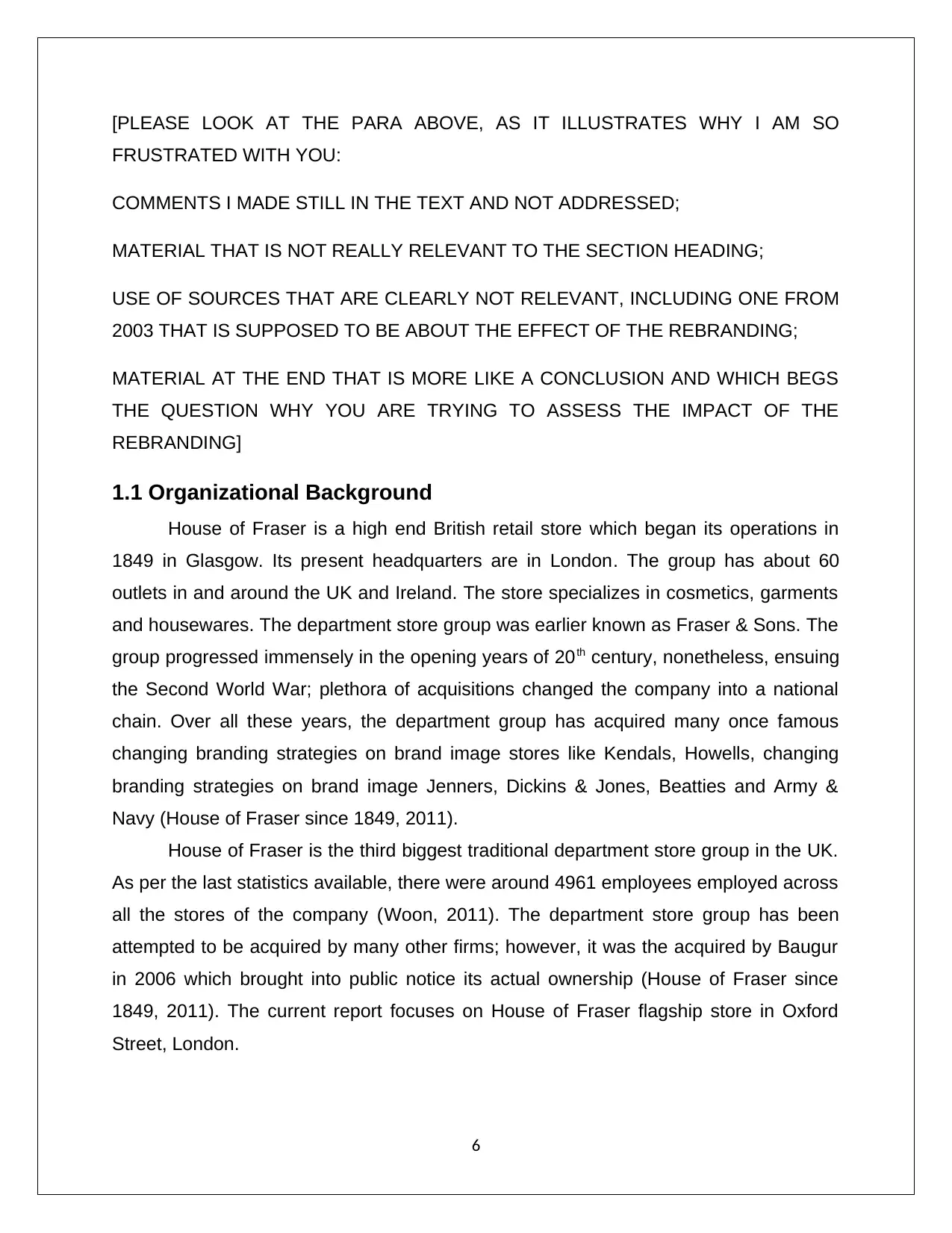
[PLEASE LOOK AT THE PARA ABOVE, AS IT ILLUSTRATES WHY I AM SO
FRUSTRATED WITH YOU:
COMMENTS I MADE STILL IN THE TEXT AND NOT ADDRESSED;
MATERIAL THAT IS NOT REALLY RELEVANT TO THE SECTION HEADING;
USE OF SOURCES THAT ARE CLEARLY NOT RELEVANT, INCLUDING ONE FROM
2003 THAT IS SUPPOSED TO BE ABOUT THE EFFECT OF THE REBRANDING;
MATERIAL AT THE END THAT IS MORE LIKE A CONCLUSION AND WHICH BEGS
THE QUESTION WHY YOU ARE TRYING TO ASSESS THE IMPACT OF THE
REBRANDING]
1.1 Organizational Background
House of Fraser is a high end British retail store which began its operations in
1849 in Glasgow. Its present headquarters are in London. The group has about 60
outlets in and around the UK and Ireland. The store specializes in cosmetics, garments
and housewares. The department store group was earlier known as Fraser & Sons. The
group progressed immensely in the opening years of 20th century, nonetheless, ensuing
the Second World War; plethora of acquisitions changed the company into a national
chain. Over all these years, the department group has acquired many once famous
changing branding strategies on brand image stores like Kendals, Howells, changing
branding strategies on brand image Jenners, Dickins & Jones, Beatties and Army &
Navy (House of Fraser since 1849, 2011).
House of Fraser is the third biggest traditional department store group in the UK.
As per the last statistics available, there were around 4961 employees employed across
all the stores of the company (Woon, 2011). The department store group has been
attempted to be acquired by many other firms; however, it was the acquired by Baugur
in 2006 which brought into public notice its actual ownership (House of Fraser since
1849, 2011). The current report focuses on House of Fraser flagship store in Oxford
Street, London.
6
FRUSTRATED WITH YOU:
COMMENTS I MADE STILL IN THE TEXT AND NOT ADDRESSED;
MATERIAL THAT IS NOT REALLY RELEVANT TO THE SECTION HEADING;
USE OF SOURCES THAT ARE CLEARLY NOT RELEVANT, INCLUDING ONE FROM
2003 THAT IS SUPPOSED TO BE ABOUT THE EFFECT OF THE REBRANDING;
MATERIAL AT THE END THAT IS MORE LIKE A CONCLUSION AND WHICH BEGS
THE QUESTION WHY YOU ARE TRYING TO ASSESS THE IMPACT OF THE
REBRANDING]
1.1 Organizational Background
House of Fraser is a high end British retail store which began its operations in
1849 in Glasgow. Its present headquarters are in London. The group has about 60
outlets in and around the UK and Ireland. The store specializes in cosmetics, garments
and housewares. The department store group was earlier known as Fraser & Sons. The
group progressed immensely in the opening years of 20th century, nonetheless, ensuing
the Second World War; plethora of acquisitions changed the company into a national
chain. Over all these years, the department group has acquired many once famous
changing branding strategies on brand image stores like Kendals, Howells, changing
branding strategies on brand image Jenners, Dickins & Jones, Beatties and Army &
Navy (House of Fraser since 1849, 2011).
House of Fraser is the third biggest traditional department store group in the UK.
As per the last statistics available, there were around 4961 employees employed across
all the stores of the company (Woon, 2011). The department store group has been
attempted to be acquired by many other firms; however, it was the acquired by Baugur
in 2006 which brought into public notice its actual ownership (House of Fraser since
1849, 2011). The current report focuses on House of Fraser flagship store in Oxford
Street, London.
6
⊘ This is a preview!⊘
Do you want full access?
Subscribe today to unlock all pages.

Trusted by 1+ million students worldwide
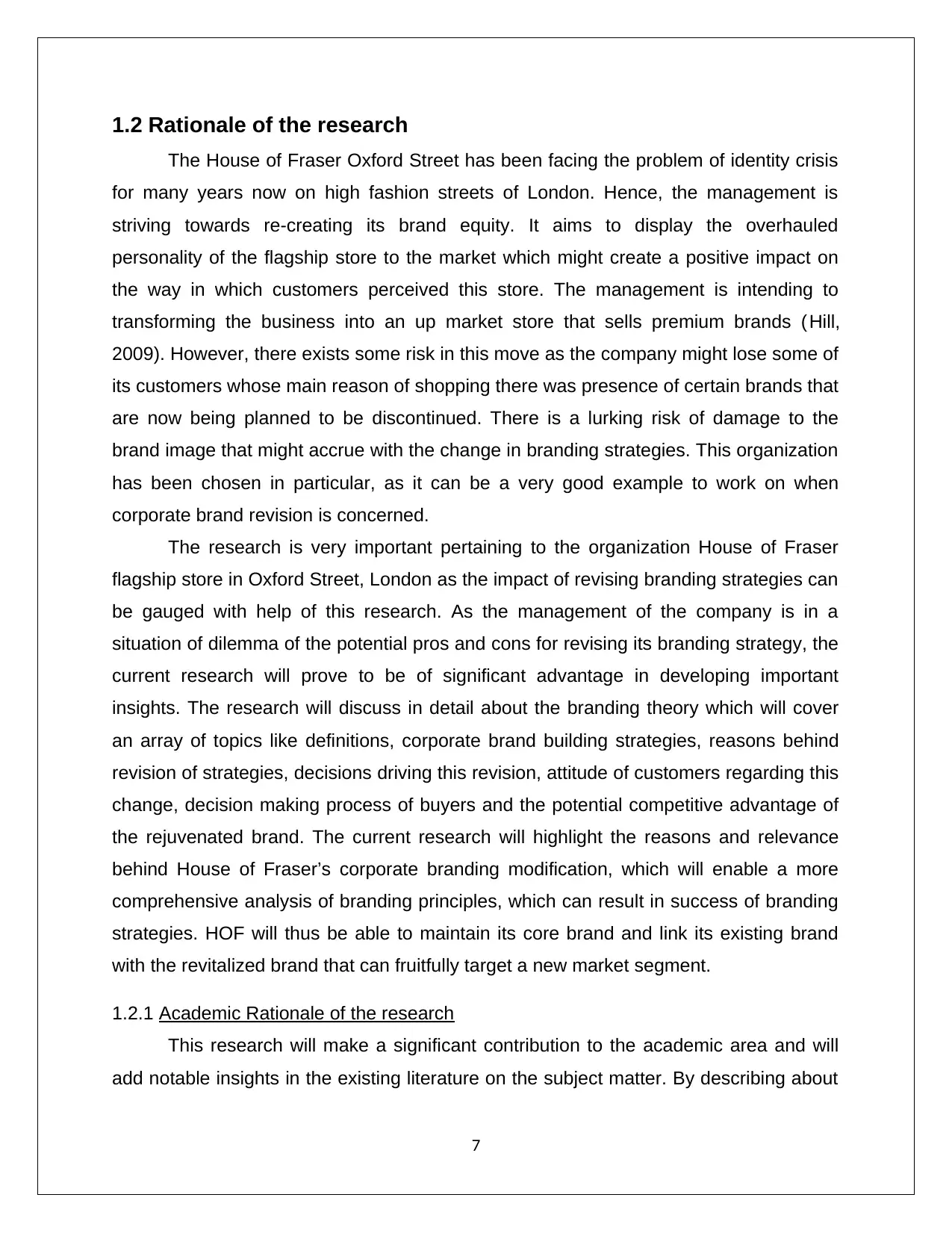
1.2 Rationale of the research
The House of Fraser Oxford Street has been facing the problem of identity crisis
for many years now on high fashion streets of London. Hence, the management is
striving towards re-creating its brand equity. It aims to display the overhauled
personality of the flagship store to the market which might create a positive impact on
the way in which customers perceived this store. The management is intending to
transforming the business into an up market store that sells premium brands ( Hill,
2009). However, there exists some risk in this move as the company might lose some of
its customers whose main reason of shopping there was presence of certain brands that
are now being planned to be discontinued. There is a lurking risk of damage to the
brand image that might accrue with the change in branding strategies. This organization
has been chosen in particular, as it can be a very good example to work on when
corporate brand revision is concerned.
The research is very important pertaining to the organization House of Fraser
flagship store in Oxford Street, London as the impact of revising branding strategies can
be gauged with help of this research. As the management of the company is in a
situation of dilemma of the potential pros and cons for revising its branding strategy, the
current research will prove to be of significant advantage in developing important
insights. The research will discuss in detail about the branding theory which will cover
an array of topics like definitions, corporate brand building strategies, reasons behind
revision of strategies, decisions driving this revision, attitude of customers regarding this
change, decision making process of buyers and the potential competitive advantage of
the rejuvenated brand. The current research will highlight the reasons and relevance
behind House of Fraser’s corporate branding modification, which will enable a more
comprehensive analysis of branding principles, which can result in success of branding
strategies. HOF will thus be able to maintain its core brand and link its existing brand
with the revitalized brand that can fruitfully target a new market segment.
1.2.1 Academic Rationale of the research
This research will make a significant contribution to the academic area and will
add notable insights in the existing literature on the subject matter. By describing about
7
The House of Fraser Oxford Street has been facing the problem of identity crisis
for many years now on high fashion streets of London. Hence, the management is
striving towards re-creating its brand equity. It aims to display the overhauled
personality of the flagship store to the market which might create a positive impact on
the way in which customers perceived this store. The management is intending to
transforming the business into an up market store that sells premium brands ( Hill,
2009). However, there exists some risk in this move as the company might lose some of
its customers whose main reason of shopping there was presence of certain brands that
are now being planned to be discontinued. There is a lurking risk of damage to the
brand image that might accrue with the change in branding strategies. This organization
has been chosen in particular, as it can be a very good example to work on when
corporate brand revision is concerned.
The research is very important pertaining to the organization House of Fraser
flagship store in Oxford Street, London as the impact of revising branding strategies can
be gauged with help of this research. As the management of the company is in a
situation of dilemma of the potential pros and cons for revising its branding strategy, the
current research will prove to be of significant advantage in developing important
insights. The research will discuss in detail about the branding theory which will cover
an array of topics like definitions, corporate brand building strategies, reasons behind
revision of strategies, decisions driving this revision, attitude of customers regarding this
change, decision making process of buyers and the potential competitive advantage of
the rejuvenated brand. The current research will highlight the reasons and relevance
behind House of Fraser’s corporate branding modification, which will enable a more
comprehensive analysis of branding principles, which can result in success of branding
strategies. HOF will thus be able to maintain its core brand and link its existing brand
with the revitalized brand that can fruitfully target a new market segment.
1.2.1 Academic Rationale of the research
This research will make a significant contribution to the academic area and will
add notable insights in the existing literature on the subject matter. By describing about
7
Paraphrase This Document
Need a fresh take? Get an instant paraphrase of this document with our AI Paraphraser
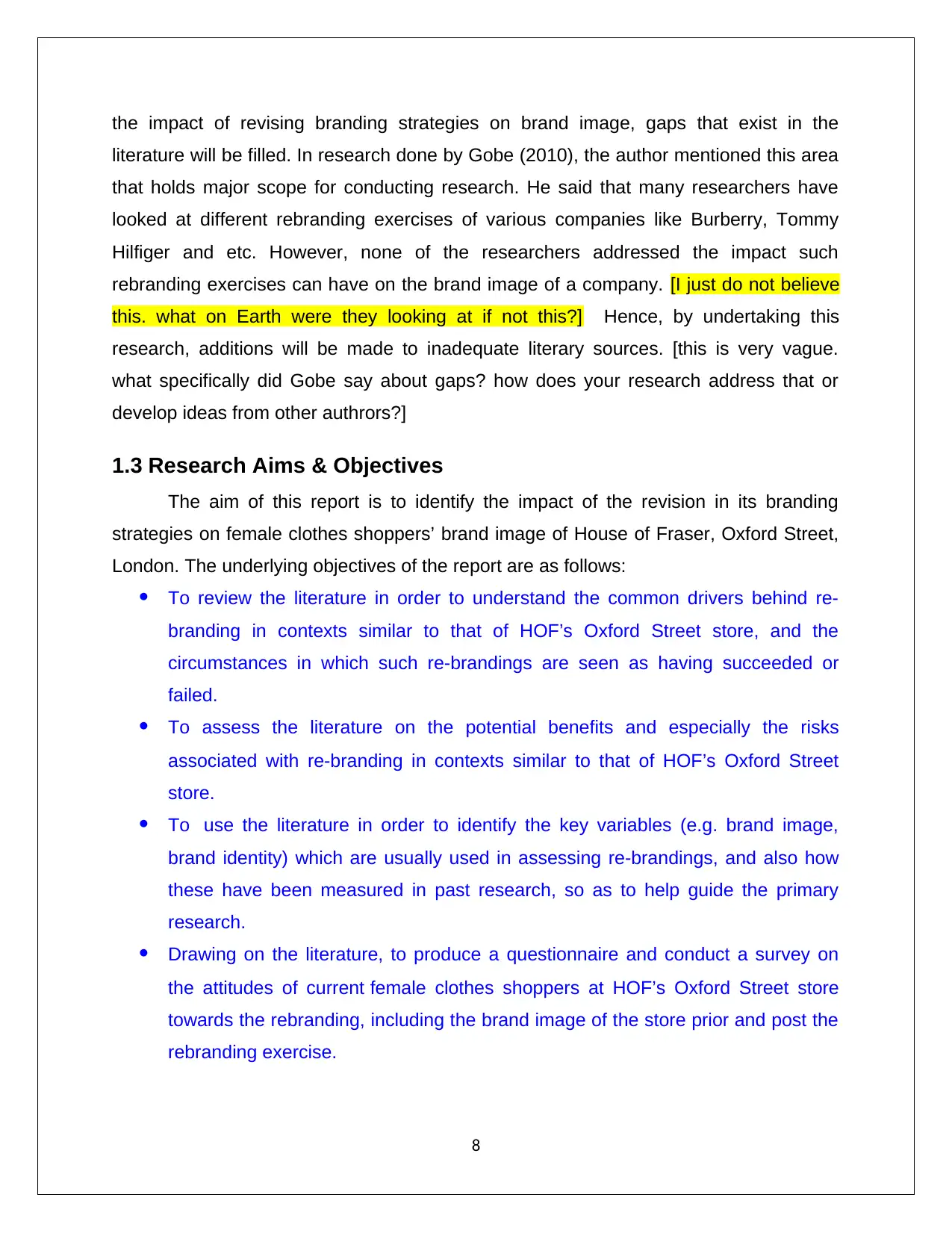
the impact of revising branding strategies on brand image, gaps that exist in the
literature will be filled. In research done by Gobe (2010), the author mentioned this area
that holds major scope for conducting research. He said that many researchers have
looked at different rebranding exercises of various companies like Burberry, Tommy
Hilfiger and etc. However, none of the researchers addressed the impact such
rebranding exercises can have on the brand image of a company. [I just do not believe
this. what on Earth were they looking at if not this?] Hence, by undertaking this
research, additions will be made to inadequate literary sources. [this is very vague.
what specifically did Gobe say about gaps? how does your research address that or
develop ideas from other authrors?]
1.3 Research Aims & Objectives
The aim of this report is to identify the impact of the revision in its branding
strategies on female clothes shoppers’ brand image of House of Fraser, Oxford Street,
London. The underlying objectives of the report are as follows:
To review the literature in order to understand the common drivers behind re-
branding in contexts similar to that of HOF’s Oxford Street store, and the
circumstances in which such re-brandings are seen as having succeeded or
failed.
To assess the literature on the potential benefits and especially the risks
associated with re-branding in contexts similar to that of HOF’s Oxford Street
store.
To use the literature in order to identify the key variables (e.g. brand image,
brand identity) which are usually used in assessing re-brandings, and also how
these have been measured in past research, so as to help guide the primary
research.
Drawing on the literature, to produce a questionnaire and conduct a survey on
the attitudes of current female clothes shoppers at HOF’s Oxford Street store
towards the rebranding, including the brand image of the store prior and post the
rebranding exercise.
8
literature will be filled. In research done by Gobe (2010), the author mentioned this area
that holds major scope for conducting research. He said that many researchers have
looked at different rebranding exercises of various companies like Burberry, Tommy
Hilfiger and etc. However, none of the researchers addressed the impact such
rebranding exercises can have on the brand image of a company. [I just do not believe
this. what on Earth were they looking at if not this?] Hence, by undertaking this
research, additions will be made to inadequate literary sources. [this is very vague.
what specifically did Gobe say about gaps? how does your research address that or
develop ideas from other authrors?]
1.3 Research Aims & Objectives
The aim of this report is to identify the impact of the revision in its branding
strategies on female clothes shoppers’ brand image of House of Fraser, Oxford Street,
London. The underlying objectives of the report are as follows:
To review the literature in order to understand the common drivers behind re-
branding in contexts similar to that of HOF’s Oxford Street store, and the
circumstances in which such re-brandings are seen as having succeeded or
failed.
To assess the literature on the potential benefits and especially the risks
associated with re-branding in contexts similar to that of HOF’s Oxford Street
store.
To use the literature in order to identify the key variables (e.g. brand image,
brand identity) which are usually used in assessing re-brandings, and also how
these have been measured in past research, so as to help guide the primary
research.
Drawing on the literature, to produce a questionnaire and conduct a survey on
the attitudes of current female clothes shoppers at HOF’s Oxford Street store
towards the rebranding, including the brand image of the store prior and post the
rebranding exercise.
8
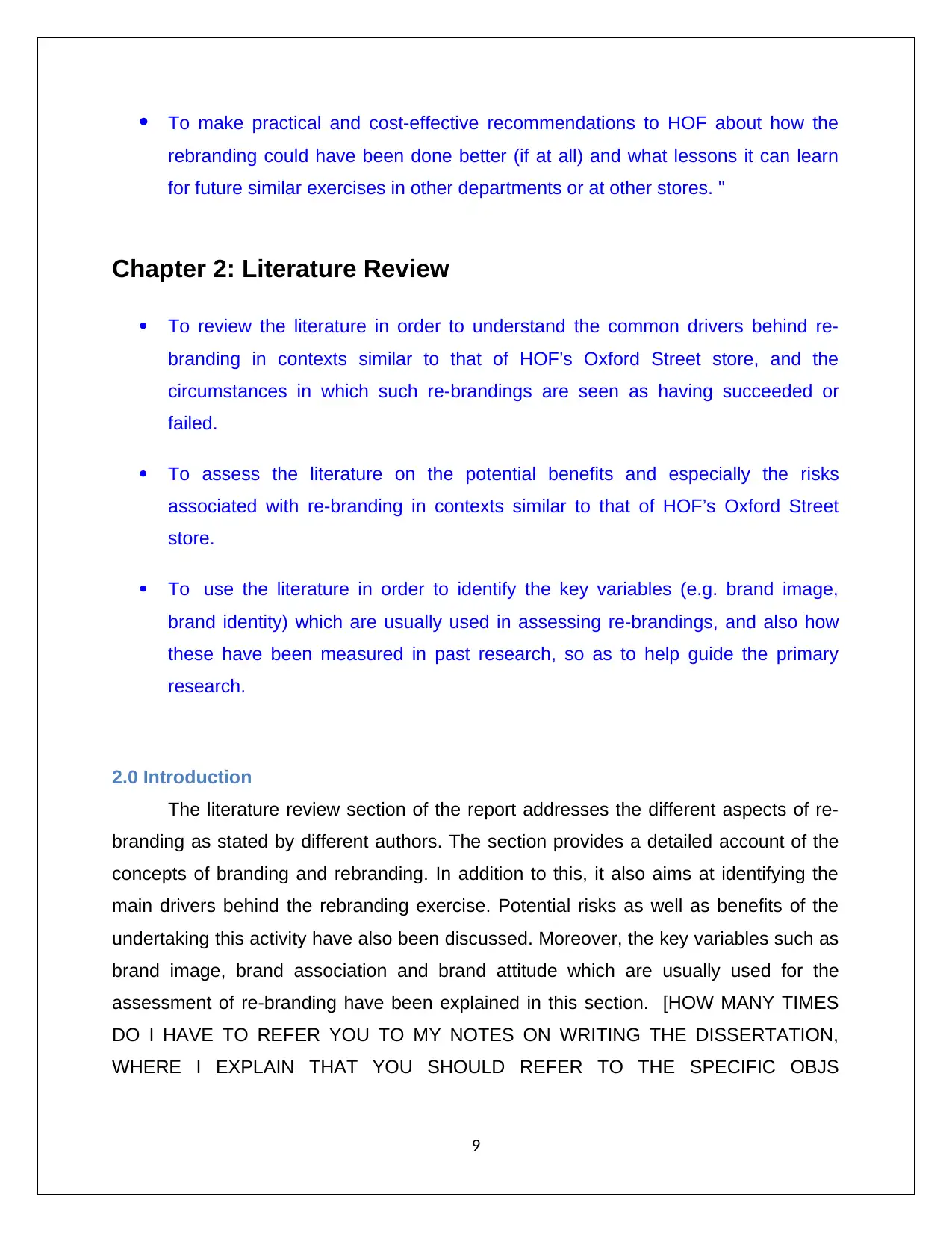
To make practical and cost-effective recommendations to HOF about how the
rebranding could have been done better (if at all) and what lessons it can learn
for future similar exercises in other departments or at other stores. "
Chapter 2: Literature Review
To review the literature in order to understand the common drivers behind re-
branding in contexts similar to that of HOF’s Oxford Street store, and the
circumstances in which such re-brandings are seen as having succeeded or
failed.
To assess the literature on the potential benefits and especially the risks
associated with re-branding in contexts similar to that of HOF’s Oxford Street
store.
To use the literature in order to identify the key variables (e.g. brand image,
brand identity) which are usually used in assessing re-brandings, and also how
these have been measured in past research, so as to help guide the primary
research.
2.0 Introduction
The literature review section of the report addresses the different aspects of re-
branding as stated by different authors. The section provides a detailed account of the
concepts of branding and rebranding. In addition to this, it also aims at identifying the
main drivers behind the rebranding exercise. Potential risks as well as benefits of the
undertaking this activity have also been discussed. Moreover, the key variables such as
brand image, brand association and brand attitude which are usually used for the
assessment of re-branding have been explained in this section. [HOW MANY TIMES
DO I HAVE TO REFER YOU TO MY NOTES ON WRITING THE DISSERTATION,
WHERE I EXPLAIN THAT YOU SHOULD REFER TO THE SPECIFIC OBJS
9
rebranding could have been done better (if at all) and what lessons it can learn
for future similar exercises in other departments or at other stores. "
Chapter 2: Literature Review
To review the literature in order to understand the common drivers behind re-
branding in contexts similar to that of HOF’s Oxford Street store, and the
circumstances in which such re-brandings are seen as having succeeded or
failed.
To assess the literature on the potential benefits and especially the risks
associated with re-branding in contexts similar to that of HOF’s Oxford Street
store.
To use the literature in order to identify the key variables (e.g. brand image,
brand identity) which are usually used in assessing re-brandings, and also how
these have been measured in past research, so as to help guide the primary
research.
2.0 Introduction
The literature review section of the report addresses the different aspects of re-
branding as stated by different authors. The section provides a detailed account of the
concepts of branding and rebranding. In addition to this, it also aims at identifying the
main drivers behind the rebranding exercise. Potential risks as well as benefits of the
undertaking this activity have also been discussed. Moreover, the key variables such as
brand image, brand association and brand attitude which are usually used for the
assessment of re-branding have been explained in this section. [HOW MANY TIMES
DO I HAVE TO REFER YOU TO MY NOTES ON WRITING THE DISSERTATION,
WHERE I EXPLAIN THAT YOU SHOULD REFER TO THE SPECIFIC OBJS
9
⊘ This is a preview!⊘
Do you want full access?
Subscribe today to unlock all pages.

Trusted by 1+ million students worldwide
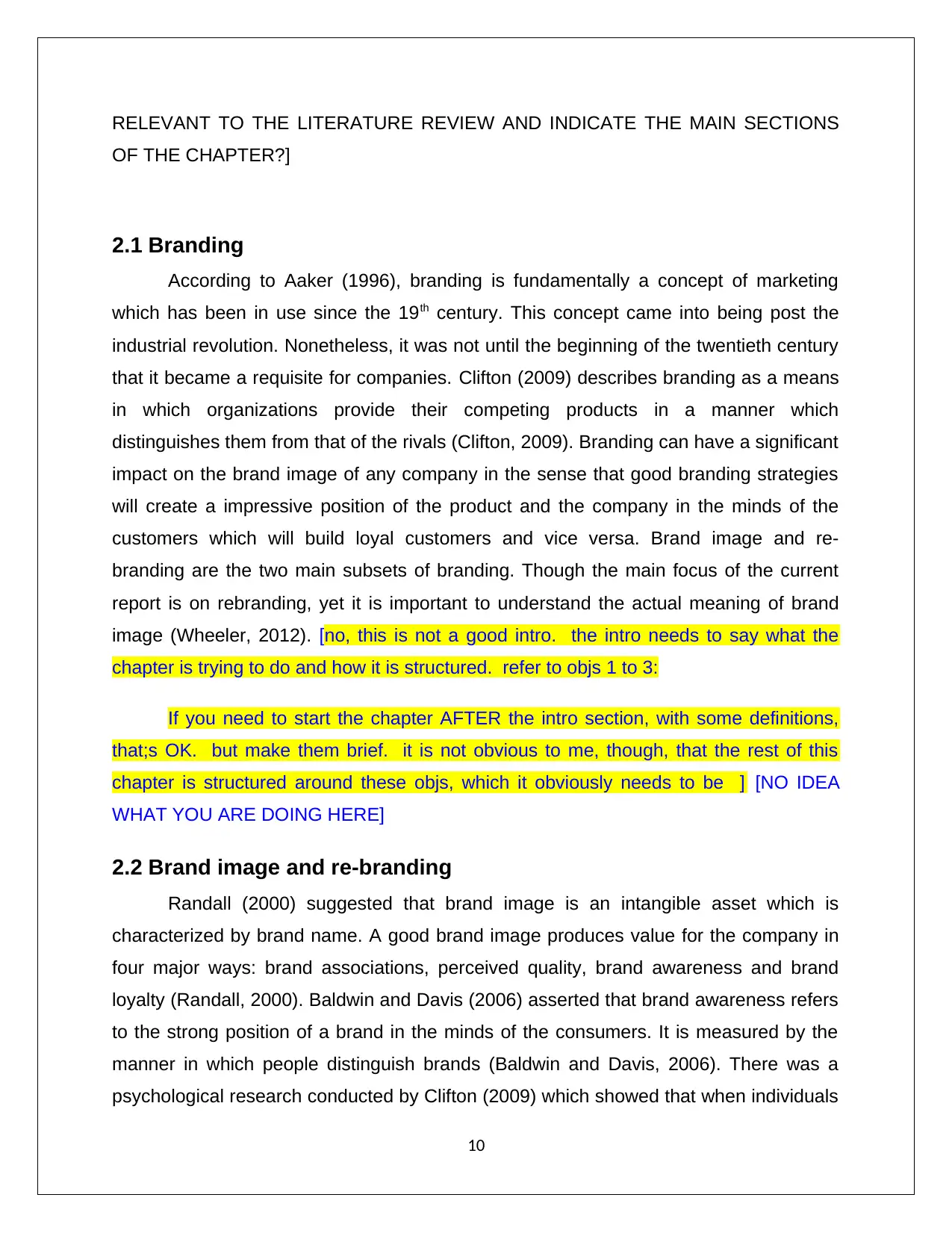
RELEVANT TO THE LITERATURE REVIEW AND INDICATE THE MAIN SECTIONS
OF THE CHAPTER?]
2.1 Branding
According to Aaker (1996), branding is fundamentally a concept of marketing
which has been in use since the 19th century. This concept came into being post the
industrial revolution. Nonetheless, it was not until the beginning of the twentieth century
that it became a requisite for companies. Clifton (2009) describes branding as a means
in which organizations provide their competing products in a manner which
distinguishes them from that of the rivals (Clifton, 2009). Branding can have a significant
impact on the brand image of any company in the sense that good branding strategies
will create a impressive position of the product and the company in the minds of the
customers which will build loyal customers and vice versa. Brand image and re-
branding are the two main subsets of branding. Though the main focus of the current
report is on rebranding, yet it is important to understand the actual meaning of brand
image (Wheeler, 2012). [no, this is not a good intro. the intro needs to say what the
chapter is trying to do and how it is structured. refer to objs 1 to 3:
If you need to start the chapter AFTER the intro section, with some definitions,
that;s OK. but make them brief. it is not obvious to me, though, that the rest of this
chapter is structured around these objs, which it obviously needs to be ] [NO IDEA
WHAT YOU ARE DOING HERE]
2.2 Brand image and re-branding
Randall (2000) suggested that brand image is an intangible asset which is
characterized by brand name. A good brand image produces value for the company in
four major ways: brand associations, perceived quality, brand awareness and brand
loyalty (Randall, 2000). Baldwin and Davis (2006) asserted that brand awareness refers
to the strong position of a brand in the minds of the consumers. It is measured by the
manner in which people distinguish brands (Baldwin and Davis, 2006). There was a
psychological research conducted by Clifton (2009) which showed that when individuals
10
OF THE CHAPTER?]
2.1 Branding
According to Aaker (1996), branding is fundamentally a concept of marketing
which has been in use since the 19th century. This concept came into being post the
industrial revolution. Nonetheless, it was not until the beginning of the twentieth century
that it became a requisite for companies. Clifton (2009) describes branding as a means
in which organizations provide their competing products in a manner which
distinguishes them from that of the rivals (Clifton, 2009). Branding can have a significant
impact on the brand image of any company in the sense that good branding strategies
will create a impressive position of the product and the company in the minds of the
customers which will build loyal customers and vice versa. Brand image and re-
branding are the two main subsets of branding. Though the main focus of the current
report is on rebranding, yet it is important to understand the actual meaning of brand
image (Wheeler, 2012). [no, this is not a good intro. the intro needs to say what the
chapter is trying to do and how it is structured. refer to objs 1 to 3:
If you need to start the chapter AFTER the intro section, with some definitions,
that;s OK. but make them brief. it is not obvious to me, though, that the rest of this
chapter is structured around these objs, which it obviously needs to be ] [NO IDEA
WHAT YOU ARE DOING HERE]
2.2 Brand image and re-branding
Randall (2000) suggested that brand image is an intangible asset which is
characterized by brand name. A good brand image produces value for the company in
four major ways: brand associations, perceived quality, brand awareness and brand
loyalty (Randall, 2000). Baldwin and Davis (2006) asserted that brand awareness refers
to the strong position of a brand in the minds of the consumers. It is measured by the
manner in which people distinguish brands (Baldwin and Davis, 2006). There was a
psychological research conducted by Clifton (2009) which showed that when individuals
10
Paraphrase This Document
Need a fresh take? Get an instant paraphrase of this document with our AI Paraphraser
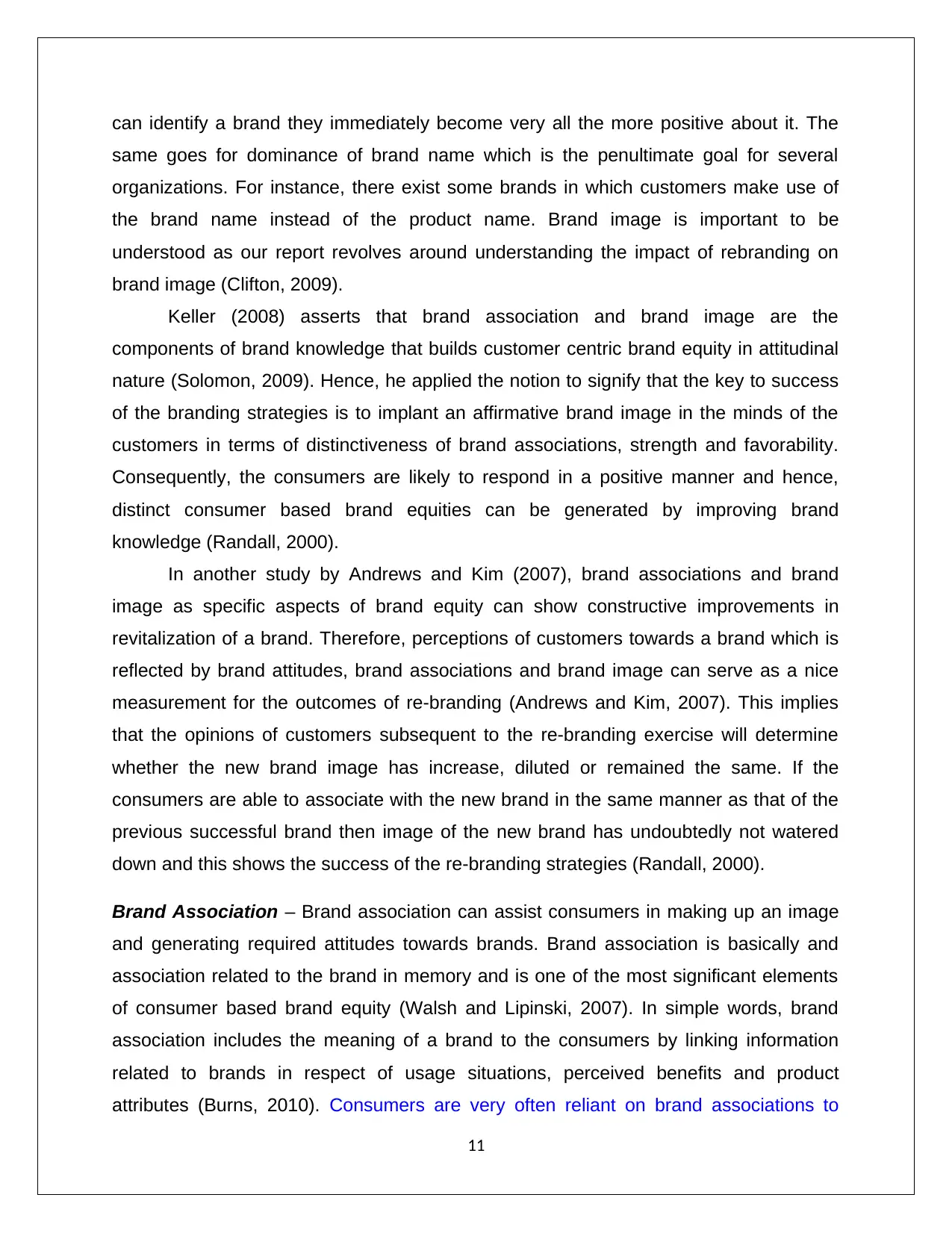
can identify a brand they immediately become very all the more positive about it. The
same goes for dominance of brand name which is the penultimate goal for several
organizations. For instance, there exist some brands in which customers make use of
the brand name instead of the product name. Brand image is important to be
understood as our report revolves around understanding the impact of rebranding on
brand image (Clifton, 2009).
Keller (2008) asserts that brand association and brand image are the
components of brand knowledge that builds customer centric brand equity in attitudinal
nature (Solomon, 2009). Hence, he applied the notion to signify that the key to success
of the branding strategies is to implant an affirmative brand image in the minds of the
customers in terms of distinctiveness of brand associations, strength and favorability.
Consequently, the consumers are likely to respond in a positive manner and hence,
distinct consumer based brand equities can be generated by improving brand
knowledge (Randall, 2000).
In another study by Andrews and Kim (2007), brand associations and brand
image as specific aspects of brand equity can show constructive improvements in
revitalization of a brand. Therefore, perceptions of customers towards a brand which is
reflected by brand attitudes, brand associations and brand image can serve as a nice
measurement for the outcomes of re-branding (Andrews and Kim, 2007). This implies
that the opinions of customers subsequent to the re-branding exercise will determine
whether the new brand image has increase, diluted or remained the same. If the
consumers are able to associate with the new brand in the same manner as that of the
previous successful brand then image of the new brand has undoubtedly not watered
down and this shows the success of the re-branding strategies (Randall, 2000).
Brand Association – Brand association can assist consumers in making up an image
and generating required attitudes towards brands. Brand association is basically and
association related to the brand in memory and is one of the most significant elements
of consumer based brand equity (Walsh and Lipinski, 2007). In simple words, brand
association includes the meaning of a brand to the consumers by linking information
related to brands in respect of usage situations, perceived benefits and product
attributes (Burns, 2010). Consumers are very often reliant on brand associations to
11
same goes for dominance of brand name which is the penultimate goal for several
organizations. For instance, there exist some brands in which customers make use of
the brand name instead of the product name. Brand image is important to be
understood as our report revolves around understanding the impact of rebranding on
brand image (Clifton, 2009).
Keller (2008) asserts that brand association and brand image are the
components of brand knowledge that builds customer centric brand equity in attitudinal
nature (Solomon, 2009). Hence, he applied the notion to signify that the key to success
of the branding strategies is to implant an affirmative brand image in the minds of the
customers in terms of distinctiveness of brand associations, strength and favorability.
Consequently, the consumers are likely to respond in a positive manner and hence,
distinct consumer based brand equities can be generated by improving brand
knowledge (Randall, 2000).
In another study by Andrews and Kim (2007), brand associations and brand
image as specific aspects of brand equity can show constructive improvements in
revitalization of a brand. Therefore, perceptions of customers towards a brand which is
reflected by brand attitudes, brand associations and brand image can serve as a nice
measurement for the outcomes of re-branding (Andrews and Kim, 2007). This implies
that the opinions of customers subsequent to the re-branding exercise will determine
whether the new brand image has increase, diluted or remained the same. If the
consumers are able to associate with the new brand in the same manner as that of the
previous successful brand then image of the new brand has undoubtedly not watered
down and this shows the success of the re-branding strategies (Randall, 2000).
Brand Association – Brand association can assist consumers in making up an image
and generating required attitudes towards brands. Brand association is basically and
association related to the brand in memory and is one of the most significant elements
of consumer based brand equity (Walsh and Lipinski, 2007). In simple words, brand
association includes the meaning of a brand to the consumers by linking information
related to brands in respect of usage situations, perceived benefits and product
attributes (Burns, 2010). Consumers are very often reliant on brand associations to
11
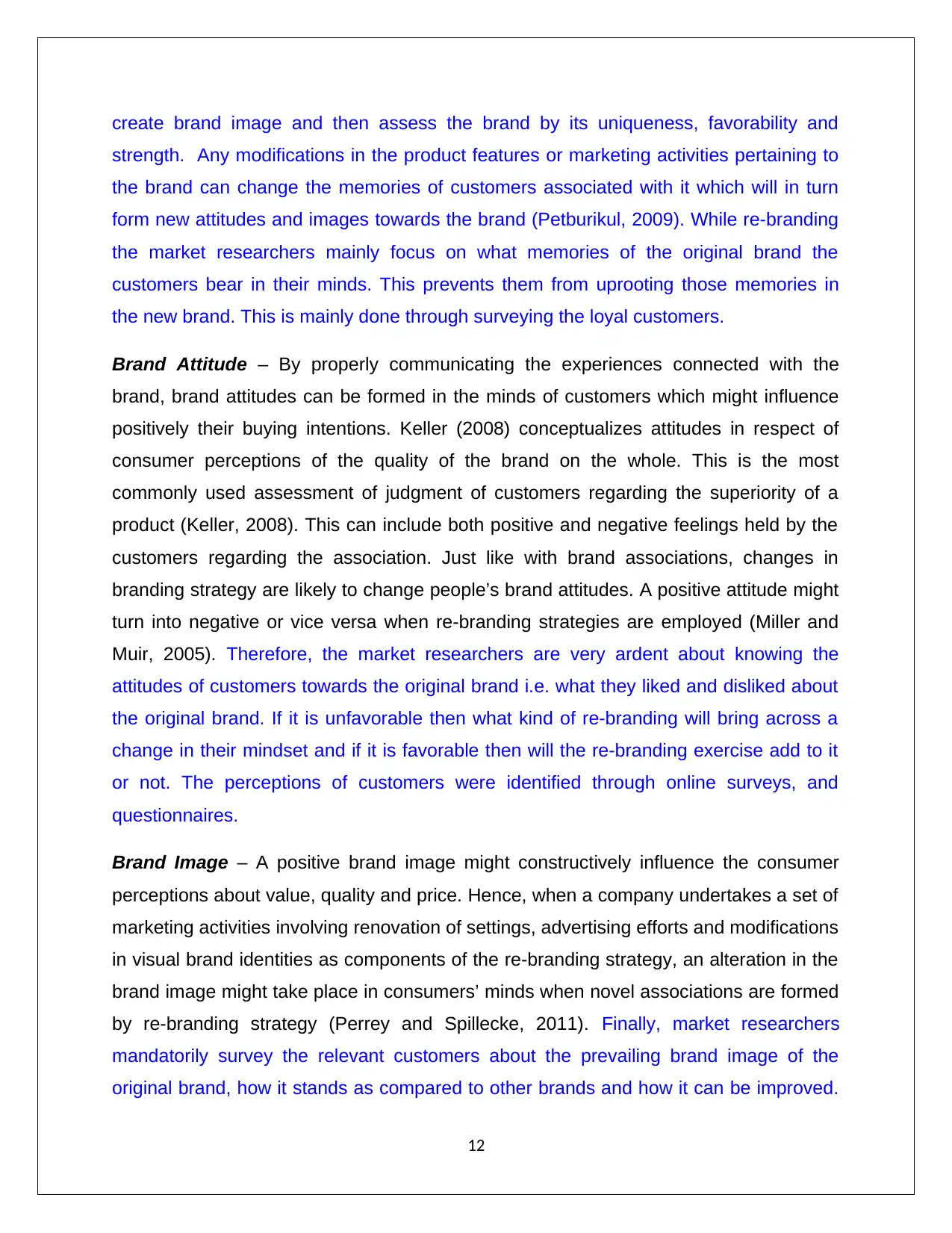
create brand image and then assess the brand by its uniqueness, favorability and
strength. Any modifications in the product features or marketing activities pertaining to
the brand can change the memories of customers associated with it which will in turn
form new attitudes and images towards the brand (Petburikul, 2009). While re-branding
the market researchers mainly focus on what memories of the original brand the
customers bear in their minds. This prevents them from uprooting those memories in
the new brand. This is mainly done through surveying the loyal customers.
Brand Attitude – By properly communicating the experiences connected with the
brand, brand attitudes can be formed in the minds of customers which might influence
positively their buying intentions. Keller (2008) conceptualizes attitudes in respect of
consumer perceptions of the quality of the brand on the whole. This is the most
commonly used assessment of judgment of customers regarding the superiority of a
product (Keller, 2008). This can include both positive and negative feelings held by the
customers regarding the association. Just like with brand associations, changes in
branding strategy are likely to change people’s brand attitudes. A positive attitude might
turn into negative or vice versa when re-branding strategies are employed (Miller and
Muir, 2005). Therefore, the market researchers are very ardent about knowing the
attitudes of customers towards the original brand i.e. what they liked and disliked about
the original brand. If it is unfavorable then what kind of re-branding will bring across a
change in their mindset and if it is favorable then will the re-branding exercise add to it
or not. The perceptions of customers were identified through online surveys, and
questionnaires.
Brand Image – A positive brand image might constructively influence the consumer
perceptions about value, quality and price. Hence, when a company undertakes a set of
marketing activities involving renovation of settings, advertising efforts and modifications
in visual brand identities as components of the re-branding strategy, an alteration in the
brand image might take place in consumers’ minds when novel associations are formed
by re-branding strategy (Perrey and Spillecke, 2011). Finally, market researchers
mandatorily survey the relevant customers about the prevailing brand image of the
original brand, how it stands as compared to other brands and how it can be improved.
12
strength. Any modifications in the product features or marketing activities pertaining to
the brand can change the memories of customers associated with it which will in turn
form new attitudes and images towards the brand (Petburikul, 2009). While re-branding
the market researchers mainly focus on what memories of the original brand the
customers bear in their minds. This prevents them from uprooting those memories in
the new brand. This is mainly done through surveying the loyal customers.
Brand Attitude – By properly communicating the experiences connected with the
brand, brand attitudes can be formed in the minds of customers which might influence
positively their buying intentions. Keller (2008) conceptualizes attitudes in respect of
consumer perceptions of the quality of the brand on the whole. This is the most
commonly used assessment of judgment of customers regarding the superiority of a
product (Keller, 2008). This can include both positive and negative feelings held by the
customers regarding the association. Just like with brand associations, changes in
branding strategy are likely to change people’s brand attitudes. A positive attitude might
turn into negative or vice versa when re-branding strategies are employed (Miller and
Muir, 2005). Therefore, the market researchers are very ardent about knowing the
attitudes of customers towards the original brand i.e. what they liked and disliked about
the original brand. If it is unfavorable then what kind of re-branding will bring across a
change in their mindset and if it is favorable then will the re-branding exercise add to it
or not. The perceptions of customers were identified through online surveys, and
questionnaires.
Brand Image – A positive brand image might constructively influence the consumer
perceptions about value, quality and price. Hence, when a company undertakes a set of
marketing activities involving renovation of settings, advertising efforts and modifications
in visual brand identities as components of the re-branding strategy, an alteration in the
brand image might take place in consumers’ minds when novel associations are formed
by re-branding strategy (Perrey and Spillecke, 2011). Finally, market researchers
mandatorily survey the relevant customers about the prevailing brand image of the
original brand, how it stands as compared to other brands and how it can be improved.
12
⊘ This is a preview!⊘
Do you want full access?
Subscribe today to unlock all pages.

Trusted by 1+ million students worldwide
1 out of 34
Related Documents
Your All-in-One AI-Powered Toolkit for Academic Success.
+13062052269
info@desklib.com
Available 24*7 on WhatsApp / Email
![[object Object]](/_next/static/media/star-bottom.7253800d.svg)
Unlock your academic potential
Copyright © 2020–2025 A2Z Services. All Rights Reserved. Developed and managed by ZUCOL.





